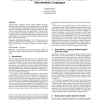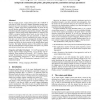275 search results - page 1 / 55 » join 2007 |
JOT
2007
13 years 4 months ago
2007
nt selection mechanism at a high-level of abstraction to decouple aspects from the application code. To this regard, we adopt a high-level pattern-based join point model, where joi...
AOSD
2007
ACM
13 years 8 months ago
2007
ACM
Aspect-oriented languages mostly employ implicit languagedefined join point models, where well-defined points in the program are called join points and declarative predicates are ...
AOSD
2007
ACM
13 years 8 months ago
2007
ACM
The last couple of years, various idioms used in the 15 MLOC C code base of ASML, the world's biggest lithography machine manufacturer, have been unmasked as crosscutting con...
IPL
2007
13 years 4 months ago
2007
In this work we consider hierarchical clustering algorithms, such as UPGMA, which follow the closest-pair joining scheme. We survey optimal O(n2)-time implementations of such algo...
SSDBM
2007
IEEE
13 years 11 months ago
2007
IEEE
Memory management is a critical issue in stream processing involving stateful operators such as join. Traditionally, the memory requirement for a stream join is query-driven: a qu...


